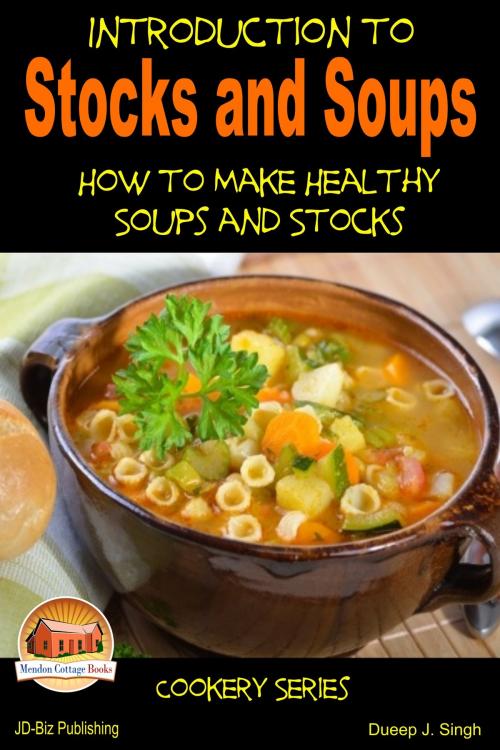Introduction to Stocks and Soups: How to Make Healthy Soups and Stocks
Nonfiction, Food & Drink, Soups & Stews| Author: | Dueep J. Singh | ISBN: | 9781311300775 |
| Publisher: | Mendon Cottage Books | Publication: | January 3, 2015 |
| Imprint: | Smashwords Edition | Language: | English |
| Author: | Dueep J. Singh |
| ISBN: | 9781311300775 |
| Publisher: | Mendon Cottage Books |
| Publication: | January 3, 2015 |
| Imprint: | Smashwords Edition |
| Language: | English |
Introduction to Stocks and Soups - How to Make Healthy Soups and Stocks
Table of Contents
Introduction
What Goes in the Stockpot
How to Prevent Stock from Turning Sour
How to Make Good Stock
Brown Stock
White Stock
How to make A Meat Glaze
Making Perfect Soup
Soup Classifications
Food Value of Thick and Clear Soups
Essentials of a Well-Prepared Soup
Why Does the Consistency Vary?
Color
Liaison
Varieties of Liaison
Tips When Using Liaisons
Roux
Proportions of Ingredients for Liaison
Consommé
Broth
Blanching
Traditional Mutton Broth
Purées
Vegetable Purées
Pulse purées
Pea or Lentil Soup
Thick Soups
Cream Soups
Tapioca Soup
Bisques
Lobster Bisque
How to Sieve Soup Properly
Conclusion
Author Bio-
Introduction
Nobody knows when human beings began to make stocks and soups from meat and vegetables. This secret is lost in the mist of the ages. Stock is a liquid which is obtained when you boil vegetable or meat over heat for a long time.
This is going to contain some of the most important and soluble nutrients and flavoring constituents of the foods which have undergone the boiling process. These nutrients have been extracted by prolonged and gentle simmering.
http://www.123rf.com/photo_14885901_vegetable-soup.html
Such a liquid is the foundation of soups, sauces and gravies in cuisines all over the world. The ancient Romans regarded a really good cook as a pearl beyond compare. Only he knew all about the herbs and spices which he was going to use in making a stock which would be then be used to make a gravy on which emperors would dine.
So is it a wonder that the first part of learning cookery is to know how to make a good stock.
The method of preparation is based upon the solvent action of the water and the prolonged application of moderate and moist heat. The gelatinous, lean and muscular tissue parts of the meat with a certain proportion of bone are most suitable to make the stock.
In ancient times, people who could not afford better cuts of meat, which went to the rich had to make do with the leftovers which were bones and pieces of lean meat. So it is natural that they tried to make these pieces very tasty by first boiling them in water. Then they added some herbs and some vegetables and then they added any available in gradient which could add to the rich flavor and aroma of something being cooked slowly on a fire.
Lo and behold, the first stock was made with the slow simmering of all these ingredients mixed together.
The importance of soup all over the world, especially in folklore cannot be disregarded. You may want to enjoy the traditional stories here about soup, from different parts of the world.
http://www.pitt.edu/~dash/type1548.html#stonesoup
Herbs and spices are not generally used for meat stock, nowadays though they were used in ancient times. Also, today they are added with discretion in fish and vegetable stocks, but like I said, in ancient times, everything went into the cooking pot and was stewed for a long time, before fed to a hungry family.
The vegetables should be fresh, not necessarily young and expensive and the trimmings and coarse stalks can be utilized. Ages ago, the food gatherer went hunting for roots, edible vegetables and other greens in the woods, and all of them were added to the cooking pot. Each portion of the plant including roots, shoots, and leaves, stems, flowers and bark if edible were utilized.
The vegetables generally used for making stock are carrots, onions, turnip and celery. Make sure that no flavor predominates.
Turnip and celery, if it is old is particularly strong and should not be used in large quantities.
Vegetables are very absorbent of meaty flavors. That is why they should not remain too long in the stock while it is cooking. This is the same reason why cooks do not let them steep for long in the stock, after the stock has been removed from the fire.
Introduction to Stocks and Soups - How to Make Healthy Soups and Stocks
Table of Contents
Introduction
What Goes in the Stockpot
How to Prevent Stock from Turning Sour
How to Make Good Stock
Brown Stock
White Stock
How to make A Meat Glaze
Making Perfect Soup
Soup Classifications
Food Value of Thick and Clear Soups
Essentials of a Well-Prepared Soup
Why Does the Consistency Vary?
Color
Liaison
Varieties of Liaison
Tips When Using Liaisons
Roux
Proportions of Ingredients for Liaison
Consommé
Broth
Blanching
Traditional Mutton Broth
Purées
Vegetable Purées
Pulse purées
Pea or Lentil Soup
Thick Soups
Cream Soups
Tapioca Soup
Bisques
Lobster Bisque
How to Sieve Soup Properly
Conclusion
Author Bio-
Introduction
Nobody knows when human beings began to make stocks and soups from meat and vegetables. This secret is lost in the mist of the ages. Stock is a liquid which is obtained when you boil vegetable or meat over heat for a long time.
This is going to contain some of the most important and soluble nutrients and flavoring constituents of the foods which have undergone the boiling process. These nutrients have been extracted by prolonged and gentle simmering.
http://www.123rf.com/photo_14885901_vegetable-soup.html
Such a liquid is the foundation of soups, sauces and gravies in cuisines all over the world. The ancient Romans regarded a really good cook as a pearl beyond compare. Only he knew all about the herbs and spices which he was going to use in making a stock which would be then be used to make a gravy on which emperors would dine.
So is it a wonder that the first part of learning cookery is to know how to make a good stock.
The method of preparation is based upon the solvent action of the water and the prolonged application of moderate and moist heat. The gelatinous, lean and muscular tissue parts of the meat with a certain proportion of bone are most suitable to make the stock.
In ancient times, people who could not afford better cuts of meat, which went to the rich had to make do with the leftovers which were bones and pieces of lean meat. So it is natural that they tried to make these pieces very tasty by first boiling them in water. Then they added some herbs and some vegetables and then they added any available in gradient which could add to the rich flavor and aroma of something being cooked slowly on a fire.
Lo and behold, the first stock was made with the slow simmering of all these ingredients mixed together.
The importance of soup all over the world, especially in folklore cannot be disregarded. You may want to enjoy the traditional stories here about soup, from different parts of the world.
http://www.pitt.edu/~dash/type1548.html#stonesoup
Herbs and spices are not generally used for meat stock, nowadays though they were used in ancient times. Also, today they are added with discretion in fish and vegetable stocks, but like I said, in ancient times, everything went into the cooking pot and was stewed for a long time, before fed to a hungry family.
The vegetables should be fresh, not necessarily young and expensive and the trimmings and coarse stalks can be utilized. Ages ago, the food gatherer went hunting for roots, edible vegetables and other greens in the woods, and all of them were added to the cooking pot. Each portion of the plant including roots, shoots, and leaves, stems, flowers and bark if edible were utilized.
The vegetables generally used for making stock are carrots, onions, turnip and celery. Make sure that no flavor predominates.
Turnip and celery, if it is old is particularly strong and should not be used in large quantities.
Vegetables are very absorbent of meaty flavors. That is why they should not remain too long in the stock while it is cooking. This is the same reason why cooks do not let them steep for long in the stock, after the stock has been removed from the fire.















